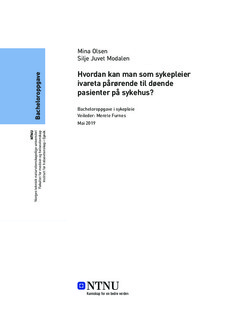| dc.contributor.advisor | Furnes, Merete | |
| dc.contributor.author | Olsen, Mina | |
| dc.contributor.author | Modalen, Silje Juvet | |
| dc.date.accessioned | 2019-09-06T14:03:28Z | |
| dc.date.available | 2019-09-06T14:03:28Z | |
| dc.date.issued | 2019 | |
| dc.identifier.uri | http://hdl.handle.net/11250/2613283 | |
| dc.description.abstract | Kort beskrivelse av bacheloroppgaven:
Hensikt: Undersøke hvordan man som sykepleier kan ivareta pårørende til døende på sykehus på en best mulig måte.
Bakgrunn: Som sykepleier på sykehus vil man møte pårørende til døende gjentatte ganger. Å ivareta pårørende er en av mange viktige oppgaver man har som sykepleier og er en del av å gi helhetlig omsorg. Omsorg beskrives etter Kari Martinsens omsorgsfilosofi.
Metode: Oppgaven besvares som en litteraturstudie bygget på vitenskapelige artikler og annen litteratur som ses relevant i besvarelsen av problemstillingen. Inklusjons- og eksklusjonskriterier er benyttet for å systematisere søket i databasene. Anvendte databaser er: MEDLINE, Cinahl, PsycINFO og PubMed.
Resultat: Resultatet viser at omsorg, støtte og inkludering er nødvendig for at pårørende skal føle seg ivaretatt. Informasjon bidrar til større forståelse av pasientsituasjon hos pårørende. Oppfatning av kommunikasjonen mellom helsepersonell og pårørende er ikke alltid sammenfallende. Opplæring, veiledning og LCP er nyttig for å opprettholde kvaliteten i omsorg for døende og deres familier.
Konklusjon: Ivaretagelse av pårørende til døende er en utfordring for sykepleiere, grunnet lite opplæring og veiledning, og bruk av tiltaksplaner. Sykepleieren må ha kunnskap om pårørendes situasjon, gode kommunikasjonsferdigheter, inkludere pårørende og gi omsorg for å kunne ivareta pårørende. | |
| dc.description.abstract | Short description of the bachelor thesis:
Aim: Ascertain how you as a nurse can take care of next of kin of dying patients in a hospital, in the best possible way.
Background: As a nurse in a hospital you will meet next of kin of dying patients repeatedly. To ascertain the next of kin is one of many important tasks you have as a nurse and is a part of giving comprehensive care. Caring is described from the care philosophy of Kari Martinsen.
Method: The thesis is answered as a study of literature, build on scientific articles and other literature which is seen as relevant in answering the thesis question. Criteria’s of inclusion and exclusion are used to systemize the search in the databases. Applied databases are: MEDLINE, Cinahl, PsycINFO and PubMed.
Results: The result shows that caring, support and inclusion are necessary for the next of kin to feel taken care of. Information contributes to greater understanding of the patient’s situation for the next of kin. The perception of communications between health care workers and next of kin are not always coinciding. Training, guidance and LCP are useful to maintain the quality in caring for the dying patients, and for their families.
Conclusion: Taking care of the next of kin in palliative care is a challenge for nurses, because of a small amount of training and guidance and the use of action plans. The nurse needs knowledge about the next of kin’s situation, good communication skills, include the next of kin and provide care to be able to take care of the next of kin. | |
| dc.language | nob | |
| dc.publisher | NTNU | |
| dc.title | Hvordan kan man som sykepleier ivareta pårørende til døende pasienter på sykehus? | |
| dc.type | Bachelor thesis | |
